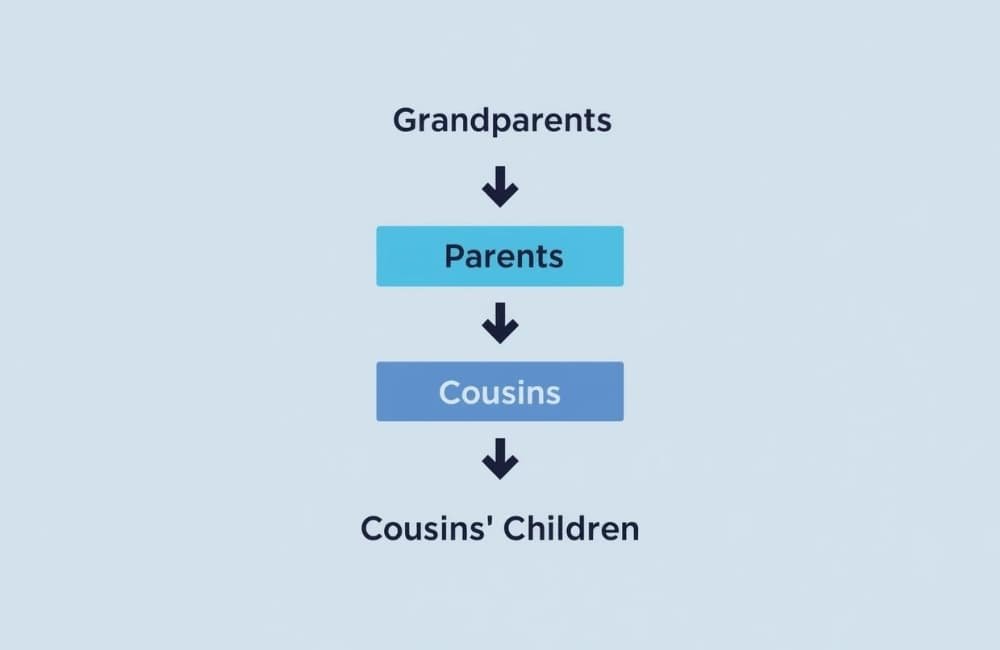Have you ever looked at your cousin’s new baby and wondered, “What am I to this little one?” You’re not alone. This question confuses a lot of people when it comes to understanding family relationships. The simple answer is that if your cousin has a baby, you are the baby’s first cousin once removed. The term “once removed” just means there’s one generation difference between you and the baby.
In other words, you and your cousin share the same grandparents, but your cousin’s child belongs to the next generation of the family tree. So, even though “first cousin once removed” sounds a bit technical, it’s just a way to show how family generations connect. Whether you call yourself a cousin, aunt, or uncle, you’re still part of the same big family just from a different branch of the tree. Let’s dive in and understand this better.
Understanding the Relationship
To truly understand this relationship, however, we must Explain what “cousin” and “removed” actually mean in family lingo. A cousin is a person who shares the same grandparents as you and that would be either your aunt or uncle’s child. If you and your cousin have parents who are siblings, then you two are first cousins because you share a generation in your family tree.
“Once removed” can seem complicated, but it simply means one generation away. If your cousin’s son or daughter is one generation away from you, you call him or her your first cousin once removed.. Similarly, if you were older and had a parent with a cousin, that child would be your first cousin once removed in the other direction, one generation up. The “removed” part is two-way, depending on whether you’re older or younger than the other person.
Family Tree Example

Illustrating that, the top of a family tree is your grandparents. They are the parents of two of your parent and your aunt. Your cousin is the child of your aunt, who is your parents’ sister or brother. This makes you and your cousin first cousins. Now, if you have a cousin who has a baby, that baby is the next generation. That baby’s relationship to you changes instead of being your “first cousin,” they are now your “first cousin once removed.”” It’s a tidy generational ladder: grandparents → parents → cousins → cousins’ children.
You might consider it as having the same roots but growing from different branches. The generation that is “once removed” is a result of the two generations bordering it: not quite part of their own family, but certainly not peers. If you have children, your children and your baby cousin will belong to the same generation. Then they will be each other’s second cousins.
What Does the Baby Call You?
While it is a “first cousin once removed” in genealogical terms not all families use the same language. Younger cousins, especially if the age difference is significant or there’s an intense emotional bond, often call older cousins “Aunt” or “Uncle.” This behavior is common in societies that value respect for elders. You’re not actually the baby’s aunt or uncle but if a colleague calls you that at work, he or she is probably expressing affection and familiarity. In the more formal terms that some families like, you may be “Cousin [Your Name]” instead. There’s absolutely no right answer here; it just depends on your family traditions and what feels right to you.
Common Misunderstandings
1. Confusion About Cousin Terminology
Many people mix up cousin terminology because it seems confusing at first glance. One of the most common misconceptions is that your cousin’s baby would be your second cousin, but that’s not accurate. A second cousin is someone who shares the same great-grandparents as you, not grandparents. It’s this one, where your parents’ cousins have children around the same age as you.
2. Misidentifying Family Roles
It’s also a popular misconception that you instantly become an aunt or uncle when your cousin has a child. Although you may feel close emotionally and fill a similar role, genealogy casts you differently. You belong to the same extended family, but you don’t share the direct parent-sibling line that makes someone a true aunt or uncle.
3. Understanding “Removed” Relationships
It’s easy to get connect in the branches of a family tree but “removed” isn’t as challenging as it seems. It just means “a generation away.” That being the case, the family’s system of relationships begins to make a lot more sense.
Frequently Asked Questions
“Once removed” indicates that two relatives are separated by one generation, such as your cousin’s child or your parent’s cousin.
Your cousin’s grandchild is your first cousin twice removed because there is a two-generation difference between you.
Yes, many families do use those titles informally, even though it’s not geneologically accurate; it’s just a cultural and affectionate convention.
Wrap up
If your cousin has a baby, then you are that baby’s first cousin once removed. This would put one generation between you and, over the course of a long life and large family, create enough distance from your common ancestors. Your cousin’s baby isn’t your second cousin, but your own baby,y and your cousin’s baby would be second cousins to each other. So the next time somebody in your family tree stretches the clan, you’ll know exactly where you fit, still near, still dear, just a baby apart. Maybe you are named Aunt, Uncle, or Cousin but what really matters is that we have the same roots.


